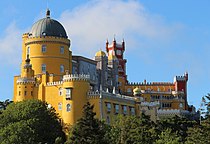Baroque architecture in Portugal

Baroque architecture in Portugal lasted about two centuries (the late seventeenth century and eighteenth century). The reigns of John V and Joseph I had increased imports of gold and diamonds, in a period called Royal Absolutism or Absolute monarchy, which allowed the Portuguese Baroque to flourish.
Baroque architecture
Baroque architecture in Portugal arose on a different timeline from the rest of Europe and was influenced by several political, artistic and economic factors.[1] It begins during a complicated moment, with the financial effort of the kingdom channelled to the Portuguese Restoration War after 60 years of Iberian Union.
Another key factor is the existence of the Jesuitical architecture, also called "plain style" (Estilo Chão).
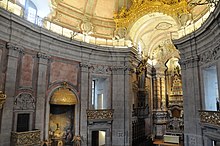
The buildings are single-room basilicas, deep main chapel, lateral chapels (with small doors for communication), without interior and exterior decoration, with a simple portal and windows. It is a very practical building, allowing it to be built throughout the empire with minor adjustments, and prepared to be decorated later or when economic resources are available. The first Portuguese Baroque does not lack in building because "plain style"” is easy to be transformed, by means of decoration (painting, tiling, etc.), turning empty areas in pompous baroque scenarios. The same could be applied to the exterior. Subsequently, it is easy to adapt the building to the taste of the time and place. Practical and economical.
The International Baroque
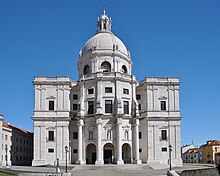
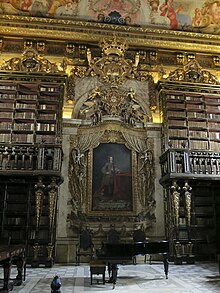
After the end of the restoration of independence war, and past the crisis of succession between
Santa Engrácia is constructed with curves and geometric forms and a centred plant and is crowned by a large dome (completed only in the twentieth century), decorated with colourful marbles and imposing itself to the city.
In the reign of King John V, the Baroque underwent a time of splendour and wealth completely new in Portugal. Despite the destruction wreaked by the 1755 earthquake, several buildings have survived. The
The
Palace of Mafra
The
Northern Portugal

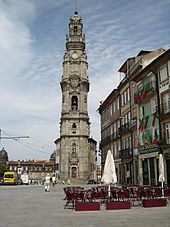
In the north of Portugal there are numerous Baroque buildings. With more inhabitants and better economic resources, the north, particularly the areas of Porto and Braga,[7] witnessed an architectural renewal, visible in the large list of churches, convents and palaces built by the aristocracy.
The city of Porto (classified heritage of humanity by UNESCO) is the city of Baroque in Portugal. It is the working area of
See also
- Architecture of Portugal
- Baroque in Brazil
- Gilded woodcarving
References
- ^ "Age of the Baroque in Portugal". www.nga.gov. Retrieved 8 May 2023.
- ^ Ferreira, Silvia. "Altares de Talha Dourada".
- ^ "A Talha Barroca de Lisboa ( 1670 - 1720)" (PDF).
- ISBN 9789898074089.
- ^ "A Biblioteca de D. João V, obra-prima do Barroco". Retrieved 8 May 2023.
- ^ Francisco Lameira; Vítor Serrão. "O retábulo em Portugal: o Barroco Final (1713-1746)" (PDF). sapientia.ualg.pt (in Portuguese). Retrieved 8 May 2023.
- JSTOR 987760.

